Installation
"PARADISO – senses + spaces"
immersive and interactive dance films
From the start, cinema entailed the recording of movement. The word "cinematography" derives from Greek: kinema -κίνημα "movement" and graphein - γράφειν "to record".
PARADISO is a series of two interactive dance films. Its two levels, "senses" and "spaces," address sensory awareness and kinesthetic learning. Dancer, researcher Bertha Bermudez (Amsterdam), filmmaker Maite Bermudez (Barcelona) and media artist and director Chris Ziegler expand cinematic experience into physicality and deliver an artistic review on the present hype surrounding 3D cinema. The film was shot in the eternal ice of the Arctic and Antarctic, in the deserts of Africa and in other inhospitable parts of the world.
In the first level of PARADISO - "senses" - the viewer is "touched" by the dancer’s movement. Force feedback sensors with electroactive polymers and a custom-built 4D chair give tactile feedback on the skin of the viewer. Image, sound, wind and evaporated perfumes activate almost all the senses: sight, hearing, touch and smell.
PARADISO’s second level - "spaces" - connects the viewer’s kinesphere to the camera of the film. Watching the dancer’s movements in the film leads the viewer into the movement of the camera’s viewing angle. In an expansion of Vertov's mental montage in early 20th century filmmaking, the viewer of PARADISO generates an interactive physical montage.
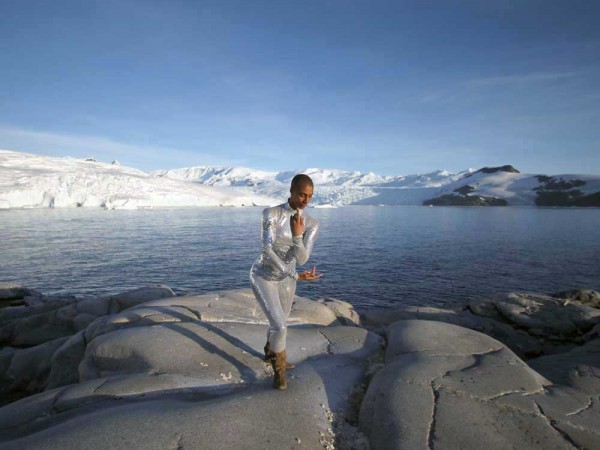 Concept, Direction: Bertha and Maite Bermúdez, Chris Ziegler
Concept, Direction: Bertha and Maite Bermúdez, Chris Ziegler
Production: Chris Ziegler – movingimages.de (DE) and Las Negras Productions (NL/SP)
Software, Space: Chris Ziegler
Dance: Bertha Bermúdez (inspired by EG | PC choreography)
Music: Emio Greco | PC's HELL, PURGATORIO, you PARA | DISO, Mikel Salas
Costume: Clifford Portier
Film director (senses): Maite Bermúdez
Camera operator: Paul Colangelo
First Assistant Camera: Randy Maldonado, Gavin Fernandaz
Grip: Sean McCague, Kurt Schwartz / Swing: Neil Kelly / DIT: Sam Kratchmere / Editing (senses): Maite Bermudez
PARADISO is the last phase of the film project film trilogy IMAGINED DANTE by Las Negras Productions, Imagined Hell, Imagined Purgatory and Imagined Paradiso. This project is inspired by choreographers Emio Greco and Pieter C. Scholten and their Dante's trilogy, Inferno, Purgatorio and you Para | Diso.
With support from The Amsterdam International Choreographic Arts Center ICK/Emio Greco | PC (NL) and Flying Elephant Foundation - Gregory Colbert (USA/FR), city council of Munich, Muffathalle Munich and Center for Art and Media ZKM Karlsruhe.
"ILLUMINATIONS"
ILLUMINATIONS is a real-time computer generated visual music installation that employs 12 6 x 8 foot screens, 12 computers and projectors, a multichannel sound system, and a large mirror. A stereoscopic version of this piece requires 3D projectors. The music, animation, installation, and Pure Data programming are by Vibeke Sorensen. Photographs are of the installation at the School of Art, Design & Media, Dance Room during the International Visual Music Symposium of the Center for Asian Art & Design, (CAAD) at Nanyang Technological University in Singapore, October 12 - 14, 2012. Thanks to Mr. Ong Kee Sing and Mr. Nagaraju Thumannapalli for their assistance.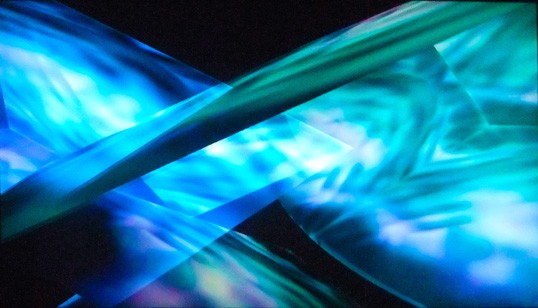
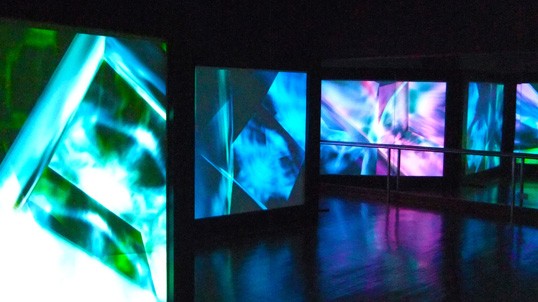
"Everything could be so much better!"
Immersive Video-Installation, Loop, 3 min
With this work Elke Reinhuber is imagining a world in which only robots are extant. They are continuously repeating the phrases, which they learned while humans were only wondering how our planet could be saved.
Audio: Sebastian Pelz and Elke Reinhuber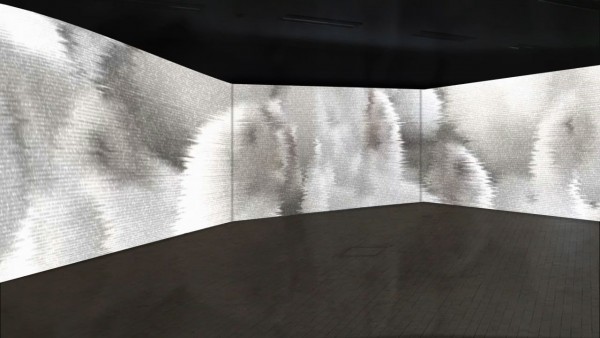
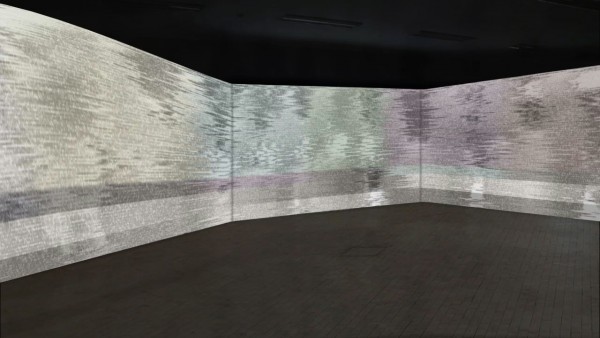
"EXILE"
In the video “Exile” Ali Gharib describes a condition in the life of a young man who wanders lost in Prague. He is living in exile, banished from his Arabian homeland.
The protagonist’s biographical backgrounds remain hidden, thus the actual reason of the banishment. Little evidence refers to a love drama, especially through the textual properties, which are an important part of the work.
“Exile” was realized with the help of the Parallax-sponsorship in 2012/13. A cooperation between the 3D department of the University for design/Expanded 3D Department, Karlsruhe and the free association CIANT, Prague.
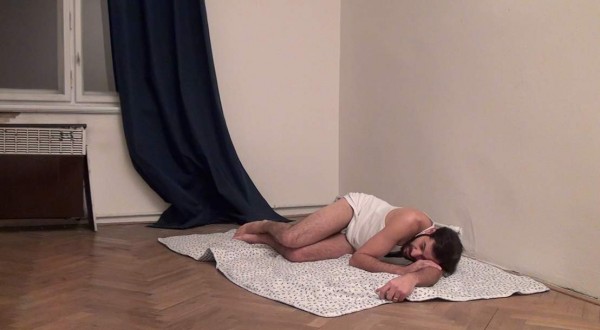
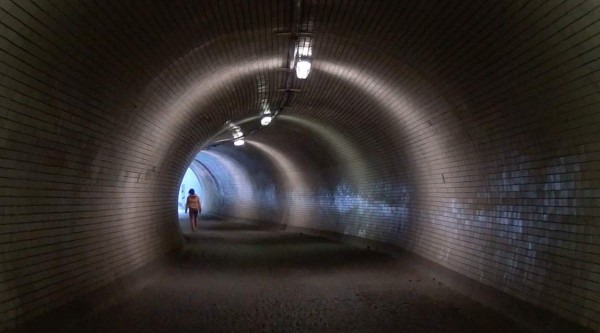
"PART 2"
PART 2 (2013) is a classic video installation. Mirror images of two CRT monitors make for a 3D-video projected on a glass pillar. The spatio-temporal reflection creates the illusion of looking at drinking glasses and a jet of water. Similar to a holography the objects appear to be floating freely in the room. In an endless loop the water flies back and forth between the glasses in a curved spurt. Meanwhile the tumblers mutually fill and empty. This sensation is due to a spatial mirroring on the vertical central axis as well as to the chronological inversion of the image halves.
Standing close to the pillar three-dimensionality accrues from the viewer seeing the reflection of the left monitor with the right eye and the reflection of the right monitor with the left eye. Both videos are perspectively shifted for the length of viewing distance. The burbling sound of water is played to and fro through the panes of the glass pillar – synchronously to the 3D-video.
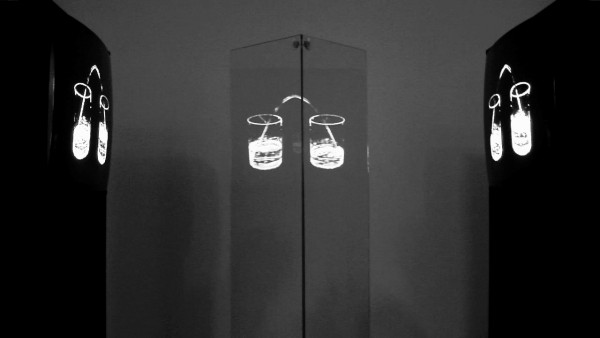
by Kilian Kretschmer
http://kiliankretschmer.com/ (Here you can also find a video about the TEIL 2 installation)
"Sculpture 1 – Sediment"
The work investigates and displays the human body and human interaction. While the term “sediment” denotes a certain type of rock, it also stands as a metaphor for emotional imagery that deposits in the subconscious over time.
The work began with an investigation of inner emotional states like happiness and despair as well as actions like flying and fighting. This basic vocabulary was translated into archetypal body postures by improvisation with a female and a male model. Their postures were recorded with a 3D camera in two separate sessions. The models did not meet during these recordings. The same camera was used to record animals in the museum of natural sciences as well as some architectural elements. In a last step the recorded sculptures were composed to form a kind of high relief and thereby set into relationship to one another.
The beholder can now use a virtual torch to cast light onto the relief and explore it in detail. The torch submerges only a very small portion of the figures in an unsteady light. A complete picture of the moments that solidified to artificial stone can thereby only be formed in the eye of the beholder..
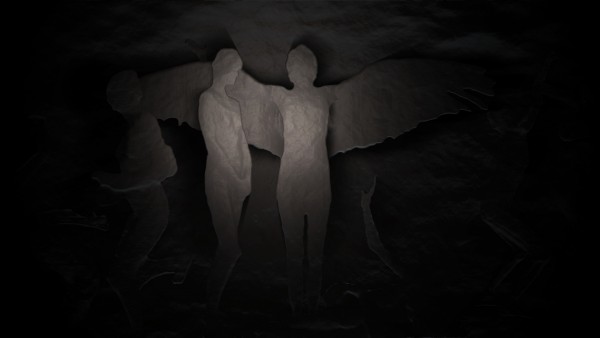
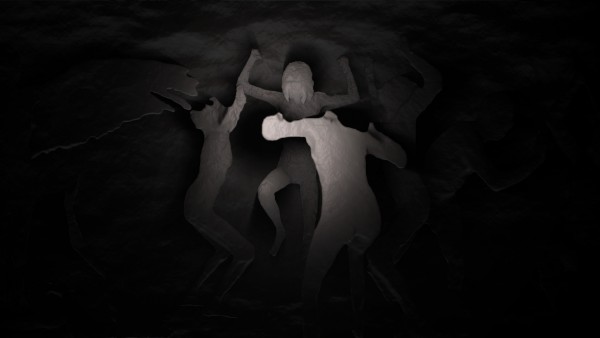
by Holger Förterer
"The Sound of Things"
“The Sound of Things“ is an interactive sound environment. In the middle of the room you find a table full of daily objects: a book, a lamp, a wineglass, an ashtray, a pen, etc.. The visitor puts on a headset and all objects on the table start to sound. The visitor can explore this soundscape in three dimensions.
Here you can also find a link which exemplifys the installation.
by Holger Förterer
"GREEN SPACE"
GREEN SPACE is a 3D stereoscopic work, 7 minutes 23 seconds in duration, with stereophonic music (mp3). Stereoscopic digital photography and 3D animation is by Vibeke Sorensen with music by David Blonski.
GREEN SPACE is in memory of Dorrit Vibekes mother, Doris Sørensen, her father Søren E. K. Sørensen, and her father's brother, Mogens Sørensen. They all passed away within six months of each other, between October 1, 2010 (Doris) and April 22, 2011 (Søren). It was completed shortly after Søren's passing away.
"Vinylaktiten / Vinylagmiten"
The origin of the sound installation „Vinylaktiten / Vinylagmiten“ is the paradox of the simultaneity of a chronology.
In addition to the sculptural shapes of the dripstones made of vinyl records which are layered one above the other, there is strange sound in the room. To every record there is an own track: fragmented sounds which cannot be traced back to their original form. They sculptural shapes manifest the momentariness of speaking. This perishability is confronted with the longevity of the dripstones.
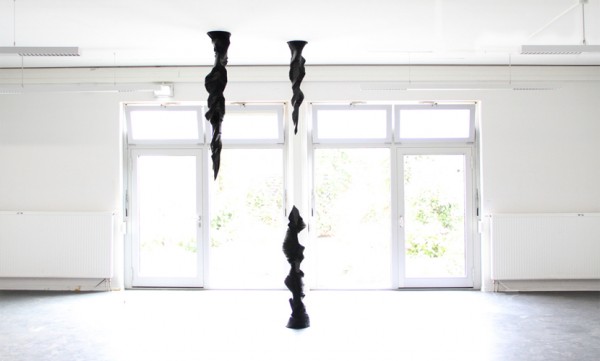
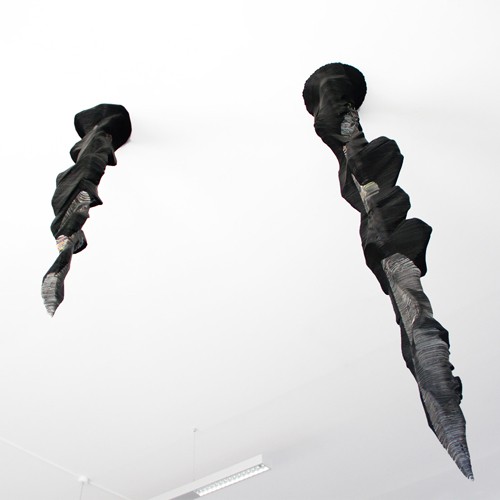
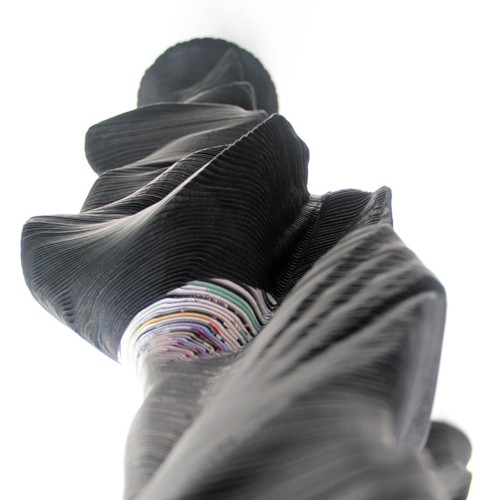
by Jens Standke www.jens-standke.de/vv
"zeitRaum"
zeitRaum challenges human perception by transforming images of a transient landscape into abstract shapes and movement into space. Form, time and stereoscopic depth become variable properties in this interactive visualisation. The project explores how visual cues such as motion parallax, binocular vision and binocular rivalry effect the human ability to read and interpret depth in a scene. The 3D depth in this visualisation is dynamic and is mapped to the proximity of a viewer to the screen. In this way, the scene opens up in if the observer approaches and gets shallower with increasing distance.
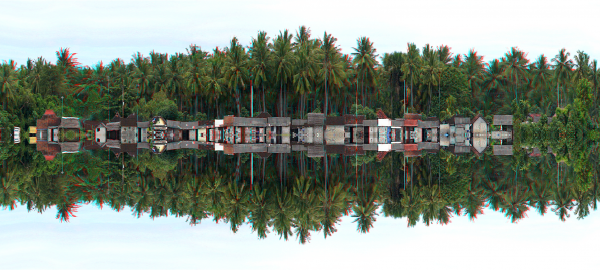
by Volker Kuchelmeister, 2013
"Ride Your Mind"
Ride Your Mind (RYM) is a prototype of an interactive, hackish, neurofeedback real-time virtual reality game art installation or, in brief, an artistic and experimental NeuroVR game that forces the user’s conscious to compete with his subconscious.
The aim of RYM is to imbue the player with an awareness of his own brain as a consciously controllable tool comparable, for example, to his hand. It achieves this aim by forcing the player’s conscious acting into competition with his subconscious acting; the player receives direct neuronal feedback showing him his unconscious brain activity, eliciting a whole new sensation of self.
The RYM concept does not ignore the fact that the game experience is a highly intimate one in which personal sensory data is temporarily stored and processed. If the user does allow the data collected to be stored or even anonymously shared, it can be interpreted by medical experts and thereby serve as a contribution to cognitive neurological research. Running a game generated by neurological data in real time requires knowledge gleaned from medical research. In other words, the game itself entails a recontextualisation of medical knowledge into a gaming and art context. Just as hackers transformed military devices into entertainment devices, RYM uses knowledge and devices from the medical world to create an artistic and experimental form of entertainment.
This artistic virtual reality game generated by neurofeedback using an Oculus Rift head-mounted display (HMD) to display a playable stereoscopic 3D visualisation of neurological signals collected by an Emotiv EEG Brain Computer Interface (BCI). The data will be processed using Unity3D, a 3D game engine software and interface manager well-suited for the desired playable data visualisation.
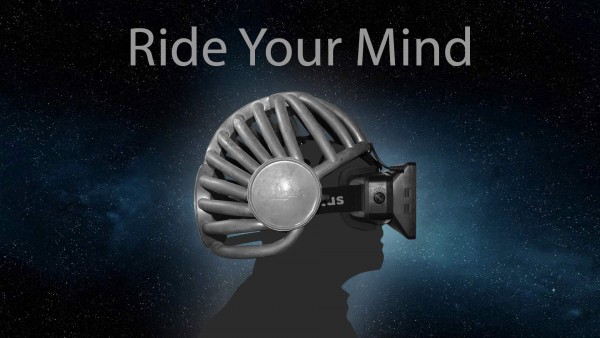
by Jens Stober
"Three-dimensional image objects – unique items and multiples - Optical irritation – visual phenomenon"
The perception of illusion and reality is the main topic of his kind of art. As a painter of paradox the English artist Patrick Hughes who was born in Birmingham in 1939 has created an international reputation.
His painted reliefs are motion images that use the medium of “Reverspective”. In illusionistic compositions he confronted the audience with the playing of continuous changing perspectives.
The surface of his unique items and multiples are parallel triangles that leading edges are facing towards the audience. He obtains this disoriented effect of his 3D-paintings by painting the furthest points on the leading edges that are facing the audience. When the spatial situation is valued false it leads to perceptual irritation. The figure that isn’t seen correctly seems to move with the passing viewer.
Patrick Hughes’ mediums and methods appear paradox but they are nevertheless in excellent consequence.
Knowledge does not replace the vision: We can see the illusion although if we already recognized them. Even by repeated view you can see it every time with astonishment: the irritation of perception.
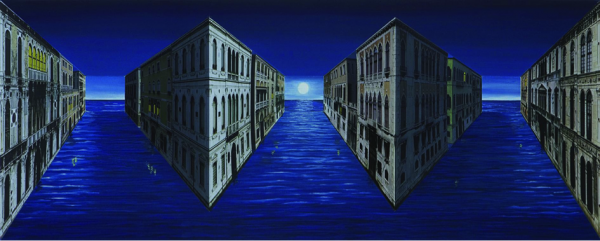
by Patrick Hughes (Gallery Boisserée)
Aristotle's Brain
 The installation "Aristotle’s Brain“ by Willi Bucher is a 3-D-projection demonstrating new ways of expression in art today. The combination of floating particles of colour and form together with minimalistic musical sounds create a “metaphysics of numbers, words and colours”.
The installation "Aristotle’s Brain“ by Willi Bucher is a 3-D-projection demonstrating new ways of expression in art today. The combination of floating particles of colour and form together with minimalistic musical sounds create a “metaphysics of numbers, words and colours”.
Within this sound- and form- installation signs and colours detach themselves from the painting or drawing in front of our very eyes. Aristotle would be confused or probably even “inspired” to see every single shape disintegrating, disappearing into “nothingness” and re-emerging out of it new. Yet perhaps it is also an impulse for a “catharsis”, a toying with the emotions and a new way of changing visible things, in which case his idea that different forms are created from the same matter, comes close to the differentiation between matter and form. The dissection and fragmentation of a head, its reduction to zeros and ones, the emergence of new spacial bodies composed of points, lines and colours are virtual processes in space. The observer is drawn into this space, becoming a surreal “wanderer” between these worlds.
In this respect “Aristotle’s Brain” exceeds the purely graphic dimension. Here Schopenhauer’s concept of man as a “metaphysics-driven being” is portrayed in its sensual form of space and shape in an interpretation of Cyberspace 3D. “Aristotle’s Brain” is a reconstructively alienated work of art, deploying a stylistic device within visual arts that is deeply etched on our cultural memory, yet presented with the technical means at our disposal today (Elmar Zorn).
Galerie Wolkonsky, Munich
Farb|Raum I (Colour|Space I) Farb|Raum II (Colour|Space II)
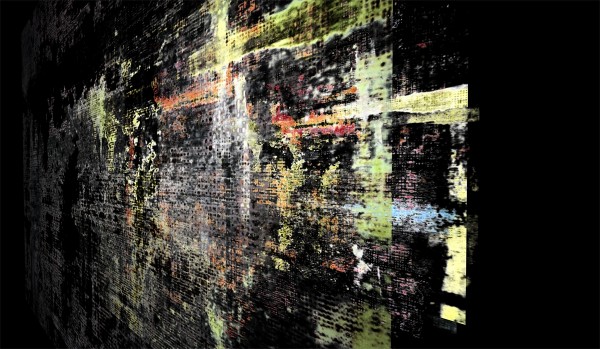 To the Italian artist Francesco Lo Savio, who in the 1960‘s was one of the first artists to visually dematerialise the painted image, the square symbolised space and the circle symbolised light. Squares and circles also predominate both of Willi Bucher‘s 3D Videos Farb|Raum I + II (Co- lour|Space I + II). He is also concerned with dematerialisation, however in a virtual sense through the use of the contemporary medium of video technology. In Farb|Raum I (Colour|Space I) a transverse oblong abstract image is seen, from which veils of colour appear to dissolve. Through the 3D-effect one experiences the sensation of diving through the various levels of the image without the picture itself disappearing. New clusters of colour continually appear out of the changing abstract images that are projected on to the back wall of a covered booth. In his work Farb|Raum (Colour|Space), using digital image generation, Bucher links in an innovative way the art of painting with the moving video picture. Through the eye of the viewer and the use of 3-D glasses the video-installation takes on an almost immersive quality for the observer, like that of a wanderer through coloured spaces.
To the Italian artist Francesco Lo Savio, who in the 1960‘s was one of the first artists to visually dematerialise the painted image, the square symbolised space and the circle symbolised light. Squares and circles also predominate both of Willi Bucher‘s 3D Videos Farb|Raum I + II (Co- lour|Space I + II). He is also concerned with dematerialisation, however in a virtual sense through the use of the contemporary medium of video technology. In Farb|Raum I (Colour|Space I) a transverse oblong abstract image is seen, from which veils of colour appear to dissolve. Through the 3D-effect one experiences the sensation of diving through the various levels of the image without the picture itself disappearing. New clusters of colour continually appear out of the changing abstract images that are projected on to the back wall of a covered booth. In his work Farb|Raum (Colour|Space), using digital image generation, Bucher links in an innovative way the art of painting with the moving video picture. Through the eye of the viewer and the use of 3-D glasses the video-installation takes on an almost immersive quality for the observer, like that of a wanderer through coloured spaces.
In Farb|Raum II (Colour|Space II) one sees, as in a surreal dream sequence, a portrait of Franz Kafkas placed however in a virtual, three di- mensional layered coloured space. Palimpsestically one colour layer visually passes through the next, without penetrating the portrait. He re- mains anchored in the projected image that repeatedly changes its colour and texture. In fact Kafka penetrates us with his piercing gaze. On the one hand the 3D-Video-Installation from Willi Bucher is like a scientific experiment, in which the different layers of the painting are virtually crisscrossed using the latest methods, on the other hand the dream-like quali- ty of the work is emphasised by the spherical music (by Anke Schimpf and Christoph Paulssen) and the dissolving colour clusters that drift to- wards the observer. Kafka appears to be hidden behind infinite masks. The binary codes, 1 and 0, that meanwhile stream from Kafka‘s eyes, represent the digital origins of the video. In the second part of Farb|Raum II (Colour|Space II), whilst Kafka‘s portrait is apparently dismantled, a rock surrounded by the sea is built up before a backdrop of architectural elements and is shown from various perspectives. This scene is based on a drawing that has been translated into an animated pixel-world. Seemingly natural, but digitally produced sounds of the sea accompany this part of the work.
by Willi Bucher
Andreas F. Beitin Curator, ZKM, Center for Art and Media|Media Museum. Museum of Con- temporary Art, Karlsruhe
VOID.1 & VOID.2
ZKM_Gameplay – The Game Platform at the ZKM Karlsruhe presents the series of VOID by Jens M. Stober, Doctoral Researcher at RMIT University’s GEElab. Starting from an endless void the artist performs an experimental and playful investigation of the Oculus Rift. The New York Times labeled this virtual reality head-mounted display (Oculus Rift) as the most advanced immersive entertainment on the horizon now. VOID.1 and VOID.2 are the first two artworks of the series. Freestanding the users can control and experience the experimental and playful virtual reality application through their head movement.
– The Game Platform at the ZKM Karlsruhe presents the series of VOID by Jens M. Stober, Doctoral Researcher at RMIT University’s GEElab. Starting from an endless void the artist performs an experimental and playful investigation of the Oculus Rift. The New York Times labeled this virtual reality head-mounted display (Oculus Rift) as the most advanced immersive entertainment on the horizon now. VOID.1 and VOID.2 are the first two artworks of the series. Freestanding the users can control and experience the experimental and playful virtual reality application through their head movement.
SAND
Kilian Kretschmer
In the middle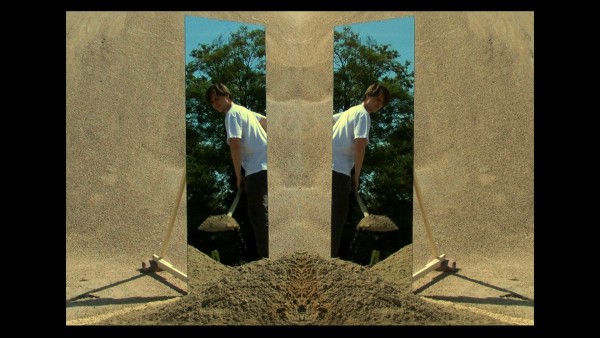 of the exhibition room is a square column made of mirrors with a height of two meters. The mirrors of the column are put up in an angle of 45 degree towards the walls, the edges point to the walls. From behind, a video is projected on the column. By the mirage in the column the projection is broken and divided, so that the left side of the video is reflected on the left wall and the right side of the video on the right wall of the room. The viewer stands in the front of the column so he or she sees the left side with the left eye and the right side with the right eye. That way the video can be perceived stereoscopic.
of the exhibition room is a square column made of mirrors with a height of two meters. The mirrors of the column are put up in an angle of 45 degree towards the walls, the edges point to the walls. From behind, a video is projected on the column. By the mirage in the column the projection is broken and divided, so that the left side of the video is reflected on the left wall and the right side of the video on the right wall of the room. The viewer stands in the front of the column so he or she sees the left side with the left eye and the right side with the right eye. That way the video can be perceived stereoscopic.
In the video the visitor can see me shoveling sand in two mirrors that face one another. In between the mirrors a completely symmetric pile of sand arises apparently coming out of nothing. The reflection functions as a separating and also as a connecting element. In the video the mirage is a digital effect and a separation between reason and effect. The viewer doesn´t see how the sand throws on the pile. Nevertheless, in the middle of the reflection one single pile of sand arises. In the exhibition room the reflection in the front of the column serves as connection. This way, both sides of the video are assembled to one picture.
Thanks to the Sand und Kieswerk Scherrieble in Weingarten for the friendly support during the shooting.
TICKETS
Your tickets for the film festival and 3D-Expert symposium are available now.
Interested? Questions? Call us:
+49 (0)721 / 8100 6001
or write us:
info@beyond-festival.com



